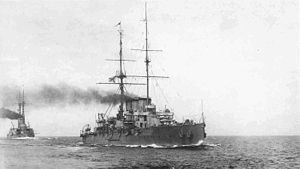Laid down August 1905 Out of service 1919 Construction started August 1905 Length 161 m Draft 7.9 m | Namesake Rurik Commissioned July 1909 Fate Scrapped 1930 Launched 4 November 1906 Weight 15,410 tons Beam 22 m | |
 | ||
Rurik (Russian: Рюрик) was an armoured cruiser built for the Imperial Russian Navy in 1906. During World War I, the ship saw service with the Baltic Fleet. She was scrapped in 1930.
Contents
Design and construction
Rurik is unusual in that she was built by Vickers in Barrow in Furness, England. She was laid down in August 1905, launched on 4 November 1906, and completed in July 1909. The Russian Navy was not usually a customer of British shipyards. She was named in honour of Rurik, the semi-legendary founder of ancient Russia.
Unlike her previous namesake, Rurik (1892), she has been described as one of the best armoured cruisers built, with advanced sprinkler protection for the magazines. She was designed by KA Tennison and AP Titov, and the contract was arranged by Basil Zaharoff. The ship had a prolonged work-up while defects were rectified.
There was a plan to build two more ships in Russia, but this was cancelled after the first battlecruiser, HMS Invincible, entered service.
Armament
The main armament consisted of four 10-inch (254 mm) guns in two turrets, and the secondary armament consisted of eight 8-inch (203 mm) guns in four twin turrets located at the corners of the superstructure. These guns were built by Vickers. The anti-torpedo boat armament comprised twenty 4.7-inch (120 mm) guns in casemates. There were also four 1.85-inch (47 mm) guns and two 18-inch (457 mm) torpedo tubes.
Gunnery trials revealed that the fastenings on the 10-inch and 8-inch barbettes were insufficiently strong and were deformed during firing. Vickers was forced to reinforce the turrets. The work was done in Kronstadt after delivery.
Protection
All plate was Krupp armour made by Vickers. The 10-inch gun turrets were protected by 8-inch (203 mm) plate, and the 8-inch gun turrets were protected by 7-inch (178 mm) plate. The main belt was 500 feet (150 m) long and extended to 5 feet (2 m) below mean water line. There was also an upper belt, 3 inches (76 mm) thick, which extended to the 4.7-inch gun battery. Each 4.7-inch gun had 1-inch (25 mm) armour screens and was separated by 1-inch armour from neighbouring guns. The forward conning tower was protected by 8-inch (203 mm) armour, and the after conning tower was protected by 5-inch (127 mm) armour.
Machinery
The power plant consisted of two four-cylinder triple-expansion steam engines and twenty-eight Belleville type boilers. On trials at the Skelmorlie mile she reached 21.43 knots (39.69 km/h; 24.66 mph), developing 20,580 hp (15,350 kW).
Service
Rurik was commissioned in 1908. She carried out a deployment to the Mediterranean in company with the battleships Tsesarevich and Slava, where she represented Russia at the coronation of King Nicholas of Montenegro.
She was the flagship of the Baltic Fleet during World War I and saw much action, being damaged by mines on several occasions. On 19 November 1916, she was damaged after striking a mine in the Baltic Sea off Hochland, laid by SM UC-27. Her crew survived, and she was refloated, repaired, and returned to service.
The ship was worn out by 1918. She was hulked in 1922 and sold for scrapping in 1930.
